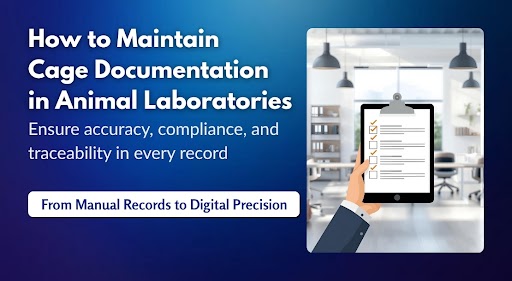
07 Oct How to Maintain Cage Documentation in Animal Laboratories
Accurate and efficient record-keeping is one of the pillars of effective laboratory animal care. From treatment records to breeding logs, good documentation ensures compliance, enhances animal welfare, and enhances overall lab operation efficiency. Paper records have proven to be inexact, lost, or time-consuming, prompting more facilities to look toward new technology. Where cage documentation within animal laboratory environments is concerned, electronic systems such as Cage Talkers provide a reliable, accurate, and scalable solution.
Why Cage Documentation is So Important in Animal Labs
In order to take flight, there is first the need to understand why cage documentation for animal laboratory facilities matters. Accurate cage records allow:
Animal identification: Accurate record-keeping of each animal or batch.
Health monitoring: Monitoring treatments, vaccinations, and medical procedures.
Breeding programs: Lineage, matings, and outcome recording.
Compliance: Monitoring AAALAC, IACUC, or GLP compliance.
Operational efficiency: Supporting researchers and technicians working in collaboration.
Without cage documentation, data integrity, animal care, and compliance audits are compromised.
Challenges with Traditional Cage Documentation
The majority of paper-recorded laboratories experience continual problems, such as:
Human errors: Writing comments by hand or omitting data cause inaccuracies.
Slow to update: Keeping hundreds or thousands of cages manually is time-consuming.
Loss or destruction of information: Card cards are easily lost, torn, or become outdated.
Auditing challenges: Government audits need traceable, detailed records that paper cannot provide.
All these issues give rise to the fact that cage documentation must be housed in a manner greater than traditional.
Best Practices for Preserving Cage Documentation
To have accurate and strong cage documentation is to embrace clear procedures and up-to-date tools. Some of the laboratory best practices to embrace are:
1. Standardize Documentation Protocols
There should be standardized templates and data-entry protocols in every laboratory. This will ensure consistency across several teams and minimize the chance of miscommunication.
Staff training plays a crucial role in precise record-keeping. Technicians, researchers, and veterinarians should be trained to update, review, and validate cage documentation correctly.
Data must be up-to-date as nearly real-time as possible. Delay in documentation of treatment or procedures can result in mismanagement and incorrect information.
Utilization of digital solutions like Cage Talkers allows for documentation within cages. Rather than paper or written cards, facilities can have accurate electronic records that update automatically across systems.
Routine inspection provides assurance that documentation procedures are being adhered to. Audits provide early gap identification and secure responsibility.
Digital Tools’ Role in Cage Documentation
Modern laboratories increasingly utilize digital means to address cage documentation for laboratory activities involving animals. Electronic cage card systems enable:
Centralized data management – All changes are retained in one system, accessible by authorized personnel.
Real-time accuracy – Data on display at the cage level is constantly updated.
Automated reminders – Treatment reminders, cage swaps, or breeding events eliminate human error.Audit-ready records – Electronic logs include full traceability for regulatory compliance.
Why Choose Cage Talkers for Cage Documentation
Of all the electronic products, Cage Talkers are a strong lab animal tool. These electronic cage cards substitute paper cards with intelligent displays connected to a central control system. The following are reasons why they’re a winner:
Seamless integration: Cage Talkers integrates with current lab management software for hassle-free operation.
Wireless updates: Data updates are performed automatically without human effort.
Multi-page display: Complete animal information can be displayed without clutter.
Reduction of mistakes: Cage Talkers steer clear of manual data entry and hence mistakes are reduced.
Ease of compliance: Computerized records and audit trails facilitate inspections by regulators.
The use of Cage Talkers improves accuracy, streamlines, and adds transparency to animal management.
Long-Term Success through Keeping Records
The secret of sustainable documentation in animal labs is less a matter of acquiring the proper technology than of keeping it in working condition. Regular updating of software, regular training of staff, and regular audit ensure that the system keeps providing accurate and reliable information.
Experimental facilities that use conventional procedures with electronic tools, such as Cage Talkers, are able to run large operations effectively without irritating regulatory agencies.
Conclusion
Cage recording in animal lab facilities is a critical task directly affecting animal well-being, data validity, and regulatory compliance. As the conventional paper-based process is typically lacking, electronic solutions like Cage Talkers provide a solid, accurate, and effective alternative.
By embracing best practices, educating staff, and employing existing electronic cage card programs, laboratories can ensure long-term achievement in colony management. For today’s research environment, converting to digital records is no longer a choice; it is a requirement.


